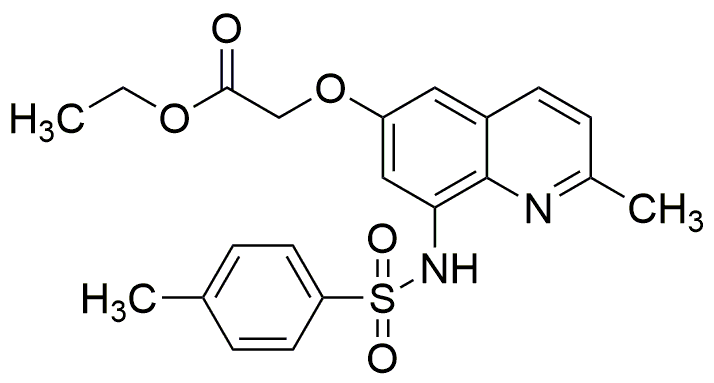Zinquin ethyl ester is widely utilized in research focused on:
- Fluorescent Probes: This compound serves as a fluorescent probe for detecting zinc ions in biological systems, making it invaluable in cellular biology and biochemistry studies.
- Neuroscience Research: It aids in understanding zinc's role in neurotransmission and neuroprotection, providing insights into neurological disorders.
- Drug Development: Its properties are explored in the development of new pharmaceuticals, particularly those targeting metal ion interactions in various diseases.
- Environmental Monitoring: Zinquin ethyl ester can be used to assess zinc levels in environmental samples, helping in pollution control and ecological studies.
- Material Science: The compound is investigated for its potential applications in creating advanced materials with specific optical properties.
General Information
Properties
Safety and Regulations
Applications
Zinquin ethyl ester is widely utilized in research focused on:
- Fluorescent Probes: This compound serves as a fluorescent probe for detecting zinc ions in biological systems, making it invaluable in cellular biology and biochemistry studies.
- Neuroscience Research: It aids in understanding zinc's role in neurotransmission and neuroprotection, providing insights into neurological disorders.
- Drug Development: Its properties are explored in the development of new pharmaceuticals, particularly those targeting metal ion interactions in various diseases.
- Environmental Monitoring: Zinquin ethyl ester can be used to assess zinc levels in environmental samples, helping in pollution control and ecological studies.
- Material Science: The compound is investigated for its potential applications in creating advanced materials with specific optical properties.
Documents
Safety Data Sheets (SDS)
The SDS provides comprehensive safety information on handling, storage, and disposal of the product.
Product Specification (PS)
The PS provides a comprehensive breakdown of the product’s properties, including chemical composition, physical state, purity, and storage requirements. It also details acceptable quality ranges and the product's intended applications.
Certificates of Analysis (COA)
Search for Certificates of Analysis (COA) by entering the products Lot Number. Lot and Batch Numbers can be found on a product’s label following the words ‘Lot’ or ‘Batch’.
*Catalog Number
*Lot Number
Certificates Of Origin (COO)
This COO confirms the country where the product was manufactured, and also details the materials and components used in it and whether it is derived from natural, synthetic, or other specific sources. This certificate may be required for customs, trade, and regulatory compliance.
*Catalog Number
*Lot Number
Safety Data Sheets (SDS)
The SDS provides comprehensive safety information on handling, storage, and disposal of the product.
DownloadProduct Specification (PS)
The PS provides a comprehensive breakdown of the product’s properties, including chemical composition, physical state, purity, and storage requirements. It also details acceptable quality ranges and the product's intended applications.
DownloadCertificates of Analysis (COA)
Search for Certificates of Analysis (COA) by entering the products Lot Number. Lot and Batch Numbers can be found on a product’s label following the words ‘Lot’ or ‘Batch’.
*Catalog Number
*Lot Number
Certificates Of Origin (COO)
This COO confirms the country where the product was manufactured, and also details the materials and components used in it and whether it is derived from natural, synthetic, or other specific sources. This certificate may be required for customs, trade, and regulatory compliance.


